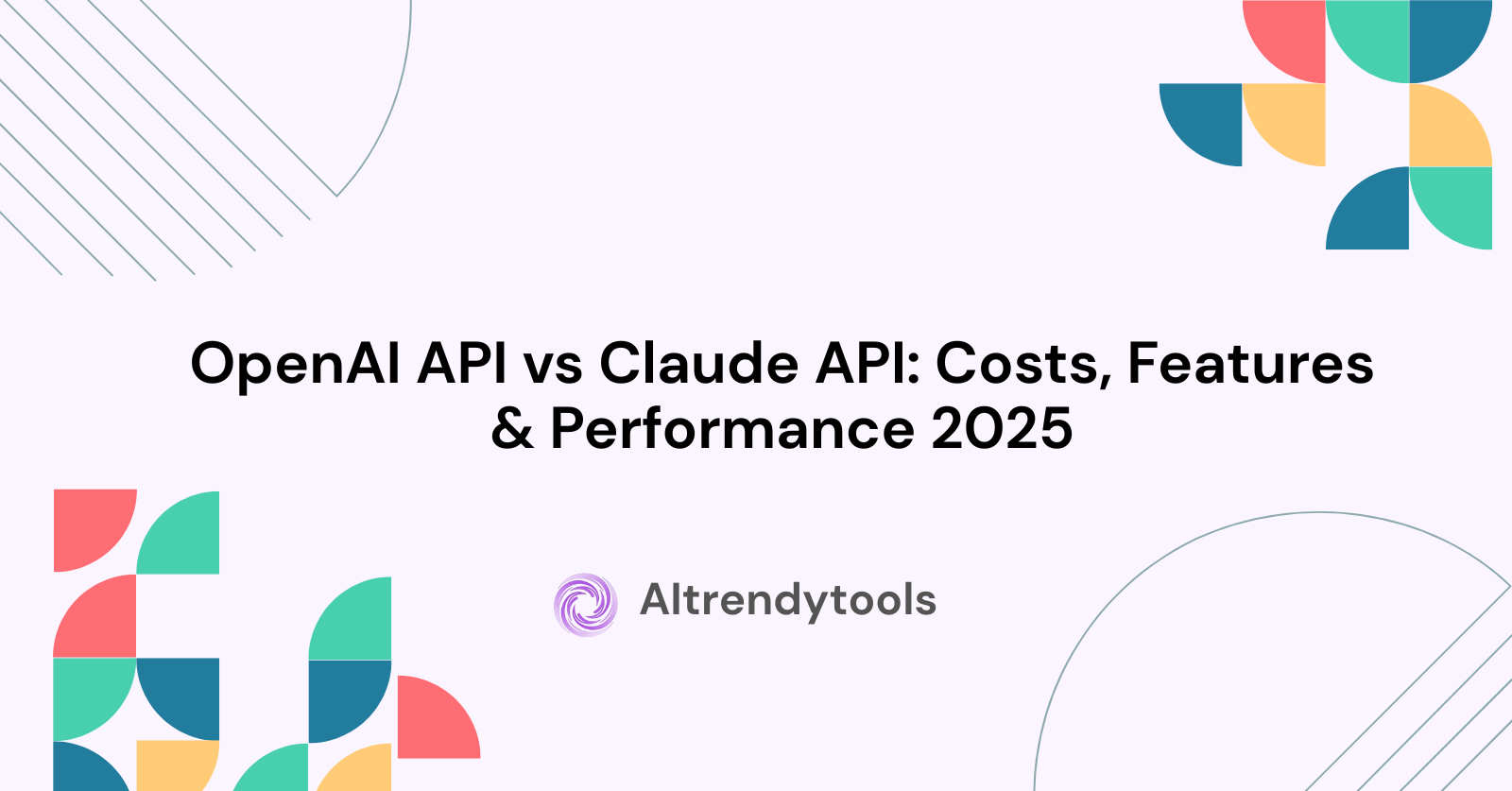🔥 AITrendytools: The Fastest-Growing AI Platform |
Write for usOpenAI API vs Claude API: Costs, Features & Performance 2025
Compare OpenAI and Claude APIs in 2025. Discover pricing, performance benchmarks, and best use cases to choose the right AI API for your project.
Nov 7, 2025
Choosing the right AI API can make or break your development project. OpenAI and Anthropic both offer powerful language models, but they serve different needs and budgets.
This guide breaks down everything you need to know about OpenAI API versus Claude API. You'll discover which API fits your use case, how much you'll actually spend, and what features matter most for your project.
Understanding AI API Pricing Models in 2025
AI APIs charge based on tokens processed. A token represents roughly 4 characters or 0.75 words in English.
Both platforms use input tokens (your prompts) and output tokens (AI responses). Output tokens typically cost more because generating text requires more computational power than processing it.
Token calculation example:
- Prompt: "Explain machine learning" = ~3 input tokens
- Response: "Machine learning is a subset of artificial intelligence..." = ~15-20 output tokens
The total cost equals your input tokens multiplied by the input rate, plus output tokens multiplied by the output rate.
OpenAI API Pricing Structure
OpenAI offers multiple model tiers with varying capabilities and costs.
GPT-5 (Latest flagship model):
- Input: $30 per million tokens
- Output: $60 per million tokens
- Context window: 1 million tokens
- Best for: Complex reasoning, agentic applications
GPT-4.1 Series:
- Input: $10 per million tokens
- Output: $30 per million tokens
- Context window: 200,000 tokens
- Best for: General-purpose applications
GPT-4.1 Mini:
- Input: $2.50 per million tokens
- Output: $10 per million tokens
- Best for: High-volume, cost-sensitive projects
OpenAI also provides specialized models for specific tasks. Their audio models handle speech-to-text and text-to-speech conversions. Image generation through DALL-E 3 costs separately based on resolution and quality.
Claude API Pricing Breakdown
Anthropic structures Claude pricing across different model families.
Claude Sonnet 4.5 (Newest model):
- Input: $3 per million tokens
- Output: $15 per million tokens
- Context window: 200,000 tokens (1M available in beta)
- Best for: Coding, autonomous agents
Claude Opus 4.1 (Most intelligent):
- Input: $15 per million tokens
- Output: $75 per million tokens
- Context window: 200,000 tokens
- Best for: Complex analysis, research
Claude Sonnet 3.7:
- Input: $3 per million tokens
- Output: $15 per million tokens
- Hybrid reasoning model
- Best for: Balanced performance
Claude Haiku 3.5:
- Input: $0.25 per million tokens
- Output: $1.25 per million tokens
- Best for: High-volume, simple tasks
Claude models include thinking tokens for tool use and complex reasoning. These tokens get charged when the model uses external tools or performs multi-step analysis before generating responses.
Cost Comparison for Real-World Use Cases
Understanding theoretical pricing helps, but seeing actual costs for common scenarios provides better guidance.
Customer Support Chatbot
A typical customer support chatbot handles 10,000 queries monthly.
Average query specs:
- Input: 500 tokens (question + chat history)
- Output: 300 tokens (response)
Using GPT-4.1 Mini:
- Input cost: (10,000 × 500 ÷ 1,000,000) × $2.50 = $12.50
- Output cost: (10,000 × 300 ÷ 1,000,000) × $10 = $30
- Total: $42.50/month
Using Claude Sonnet 4.5:
- Input cost: (10,000 × 500 ÷ 1,000,000) × $3 = $15
- Output cost: (10,000 × 300 ÷ 1,000,000) × $15 = $45
- Total: $60/month
Using Claude Haiku 3.5:
- Input cost: (10,000 × 500 ÷ 1,000,000) × $0.25 = $1.25
- Output cost: (10,000 × 300 ÷ 1,000,000) × $1.25 = $3.75
- Total: $5/month
For high-volume customer support with straightforward queries, Claude Haiku offers massive savings. The model handles simple classification and response generation at a fraction of the cost.
Content Generation Platform
Content platforms generate articles, product descriptions, and marketing copy.
Typical workload:
- 1,000 articles per month
- Input: 200 tokens (instructions + context)
- Output: 800 tokens (generated content)
Using GPT-5:
- Input cost: (1,000 × 200 ÷ 1,000,000) × $30 = $6
- Output cost: (1,000 × 800 ÷ 1,000,000) × $60 = $48
- Total: $54/month
Using Claude Opus 4.1:
- Input cost: (1,000 × 200 ÷ 1,000,000) × $15 = $3
- Output cost: (1,000 × 800 ÷ 1,000,000) × $75 = $60
- Total: $63/month
Using Claude Sonnet 4.5:
- Input cost: (1,000 × 200 ÷ 1,000,000) × $3 = $0.60
- Output cost: (1,000 × 800 ÷ 1,000,000) × $15 = $12
- Total: $12.60/month
Claude Sonnet 4.5 delivers exceptional value for content generation. The model produces natural, engaging text at significantly lower costs than premium alternatives.
Code Assistant Application
Development tools process large codebases and generate complex implementations.
Monthly usage:
- 5,000 coding tasks
- Input: 1,500 tokens (code context + instructions)
- Output: 1,000 tokens (generated code)
Using GPT-5:
- Input cost: (5,000 × 1,500 ÷ 1,000,000) × $30 = $225
- Output cost: (5,000 × 1,000 ÷ 1,000,000) × $60 = $300
- Total: $525/month
Using Claude Sonnet 4.5:
- Input cost: (5,000 × 1,500 ÷ 1,000,000) × $3 = $22.50
- Output cost: (5,000 × 1,000 ÷ 1,000,000) × $15 = $75
- Total: $97.50/month
Claude Sonnet 4.5 dominates coding tasks. The model scores 72.7% on SWE-bench Verified, outperforming GPT-5 while costing 81% less.
Performance Benchmarks and Model Capabilities
Raw pricing numbers tell only part of the story. Performance benchmarks reveal which API delivers better results for specific tasks.
Coding Performance
Coding benchmarks measure how well models generate, debug, and refactor code.
SWE-bench Verified scores:
- Claude Sonnet 4.5: 72.7%
- GPT-5: 65.3%
- Claude Opus 4.1: 69.8%
HumanEval scores:
- Claude Sonnet 4.5: 92%
- GPT-5: 88.5%
- Claude Opus 4.1: 93.5%
Claude models consistently outperform OpenAI alternatives on coding benchmarks. Claude Sonnet 4.5 can work autonomously for 30 hours on complex coding tasks, compared to GPT-5's shorter attention span.
Developers using Claude report fewer errors and more production-ready code. The model understands context better and generates implementations that require less manual correction.
Reasoning and Analysis
Complex reasoning tests measure logical thinking and multi-step problem solving.
GPQA (Graduate-Level Science Questions):
- GPT-5: 78.3%
- Claude Opus 4.1: 82.1%
- Claude Sonnet 4.5: 76.5%
MMLU (Massive Multitask Language Understanding):
- GPT-5: 86.4%
- Claude Opus 4.1: 88.7%
- Claude Sonnet 4.5: 85.2%
Claude Opus 4.1 leads in complex reasoning tasks. The model excels at legal analysis, scientific research, and financial modeling where accuracy matters more than speed.
Writing Quality
Writing benchmarks evaluate creativity, coherence, and stylistic control.
User feedback consistently rates Claude higher for natural writing style. The model produces text that reads more human-like and maintains consistent tone throughout long documents.
Claude excels at:
- Creative writing with rich character development
- Professional business communication
- Technical documentation with clear explanations
- Academic writing with proper structure
OpenAI models handle:
- Quick content generation at scale
- Varied writing styles across different domains
- Multimodal content combining text and images
- Real-time conversational applications
Context Window Capabilities
Context windows determine how much information models can process simultaneously.
OpenAI context limits:
- GPT-5: 1 million tokens
- GPT-4.1: 200,000 tokens
- GPT-4.1 Mini: 128,000 tokens
Claude context limits:
- All Claude 4 models: 200,000 tokens standard
- Claude Sonnet 4/4.5: 1 million tokens (beta)
- Provides consistent performance across full window
Larger context windows enable processing entire codebases, lengthy documents, and complex conversations without losing important details. Claude was first to reach 100,000 tokens and maintains leadership in long-context understanding.
Feature Comparison for Developers
Beyond pricing and performance, specific features impact development workflow and application capabilities.
API Integration and Documentation
OpenAI advantages:
- Mature, well-documented API
- Extensive community support and examples
- Broad ecosystem of tools and integrations
- Official SDKs for multiple languages
- Detailed error handling and debugging tools
Claude advantages:
- Clean, intuitive API design
- Built-in safety features without separate moderation
- Better handling of edge cases
- Transparent thinking process for debugging
- Native support for long conversations
Both platforms provide comprehensive documentation, but OpenAI's longer market presence means more community resources and third-party tools exist.
Model Selection and Flexibility
OpenAI model options:
- Multiple GPT versions for different needs
- Specialized audio models for speech
- Image generation with DALL-E integration
- Embedding models for semantic search
- Fine-tuning capabilities for custom models
Claude model options:
- Haiku for speed and cost efficiency
- Sonnet for balanced performance
- Opus for maximum intelligence
- Hybrid reasoning modes within single models
- Extended thinking for complex problems
OpenAI offers more specialized models for different modalities. Claude focuses on text excellence with different tiers optimizing the speed-intelligence tradeoff.
Safety and Content Moderation
Safety features prevent models from generating harmful, biased, or inappropriate content.
OpenAI approach:
- Separate moderation API for content checking
- Granular control over safety settings
- Custom content filters for specific use cases
- Continuous updates based on user feedback
Claude approach:
- Built-in safety without separate API calls
- Lower rates of sycophancy and deception
- Better prompt injection resistance
- Thoughtful refusal of harmful requests
Claude embeds safety directly into models, reducing development complexity. OpenAI's modular approach provides more customization but requires additional API calls and complexity.
Tool Use and Function Calling
Modern AI applications need to interact with external tools, databases, and APIs.
OpenAI function calling:
- Mature ecosystem with broad adoption
- Supports complex tool chains
- JSON schema definition for tools
- Parallel function calls for efficiency
Claude tool use:
- Simpler, more intuitive syntax
- Better error handling and recovery
- Thinking tokens show reasoning process
- Superior multi-tool orchestration
Claude's tool use implementation makes building AI agents more straightforward. The model maintains focus better during long tool interaction sequences.
Multimodal Capabilities
Processing multiple input types (text, images, audio) expands application possibilities.
OpenAI multimodal features:
- GPT-5 analyzes images directly
- DALL-E 3 generates high-quality images
- Whisper converts speech to text
- Text-to-speech with natural voices
- Vision models describe and analyze visual content
Claude multimodal features:
- Vision capabilities in Claude 4 models
- Strong technical diagram analysis
- PDF and document processing
- Limited image generation (coming soon)
OpenAI leads in multimodal capabilities with comprehensive image and audio support. Claude focuses on text and recently added vision, with strong performance on technical diagrams and document analysis.
Best Use Cases for Each API
Different projects require different strengths. Understanding which API excels at specific tasks helps make the right choice.
When to Choose OpenAI API
Image generation and analysis: Projects requiring image creation or complex visual analysis benefit from OpenAI's DALL-E integration and advanced vision models. Marketing platforms, content creation tools, and design applications leverage these capabilities.
Multimodal applications: Applications combining text, images, and audio need OpenAI's comprehensive multimodal support. Virtual assistants, educational platforms, and accessibility tools require this flexibility.
Rapid prototyping: OpenAI's extensive ecosystem and community support accelerate development. Startups and MVP projects benefit from abundant examples, tutorials, and third-party integrations.
Consumer-facing chatbots: General-purpose conversational AI for customer service and personal assistance works well with OpenAI models. The broader training data and conversational style fit consumer applications.
Data analysis and visualization: Applications processing diverse data types and creating visualizations leverage GPT-5's analytical capabilities. Business intelligence tools and data platforms benefit from this strength.
When to Choose Claude API
Professional coding applications: Development tools, code review systems, and programming assistants should use Claude. The model's superior coding performance, 30-hour autonomous operation, and error-free editing deliver better results.
Long-form content creation: Content management systems, technical writing platforms, and creative writing tools benefit from Claude's natural style and consistency. The model maintains quality across lengthy documents.
Complex reasoning tasks: Legal analysis platforms, financial modeling tools, and research applications need Claude Opus's advanced reasoning. The model handles intricate multi-step problems with higher accuracy.
High-volume simple tasks: Customer support bots, content classification systems, and routine automation should use Claude Haiku. The dramatic cost savings enable scaling without budget concerns.
Document analysis and summarization: Contract review tools, research assistants, and document management systems leverage Claude's large context window. The model processes entire documents while maintaining coherent understanding.
Enterprise AI agents: Autonomous business process automation, compliance monitoring, and workflow orchestration work better with Claude. The model's extended thinking and reliable tool use support complex agent applications.
Cost Optimization Strategies
Smart API usage reduces costs without sacrificing performance. These strategies work for both platforms.
Prompt Engineering Best Practices
Efficient prompts minimize token usage while maintaining output quality.
Eliminate unnecessary context: Remove redundant information from prompts. Include only essential details for the task. Each word costs money, so precision matters.
Use clear, concise instructions: Direct language reduces token count. Avoid verbose explanations when simple commands suffice. The model understands brief, well-structured prompts.
Leverage system messages: System messages set behavior once rather than repeating instructions. They cost fewer tokens than including instructions in every user message.
Optimize output length: Specify desired length explicitly. Requesting "200 words" prevents unnecessarily long responses. Set maximum token limits in API calls.
Model Selection Strategy
Choosing the right model for each task optimizes cost-performance ratio.
Use tiered approach: Route simple tasks to cheaper models and complex tasks to premium models. Customer queries about business hours don't need GPT-5 or Opus.
Test multiple models: Benchmark different models on your specific use case. Sometimes mid-tier models perform adequately at lower costs.
Consider batch processing: Both platforms offer batch APIs with 50% discounts. Non-urgent tasks benefit from asynchronous processing.
Monitor performance degradation: Track when cheaper models fail to meet quality standards. Switch to premium models only when necessary.
Caching and Reuse
Prompt caching dramatically reduces costs for repeated operations.
OpenAI caching: Cached prompts cost 10x less than standard processing. Reuse system messages and common context across conversations.
Claude prompt caching: Cache reads cost 90% less than standard inputs. System prompts, code examples, and documentation benefit most from caching.
Implementation tips: Structure prompts with reusable sections first. Place variable content at the end. The API automatically caches stable portions.
Cache duration: OpenAI: Automatic management based on usage patterns Claude: 5-minute default, 1-hour option for frequently accessed content
Rate Limit Management
Understanding rate limits prevents unexpected throttling and enables capacity planning.
OpenAI rate limits:
- Tier-based system with monthly spending thresholds
- Separate limits for requests per minute and tokens per minute
- Gradual increases as usage history builds
Claude rate limits:
- Usage tier caps on monthly spend
- Per-model request and token limits
- Pre-deposits required for higher tiers
Plan usage based on limits. Spread requests over time rather than bursting. Monitor dashboard metrics to avoid hitting caps.
Implementation Considerations
Technical factors beyond pricing affect which API works better for your project.
Setup and Integration Complexity
OpenAI setup:
- Create account at platform.openai.com
- Generate API key from dashboard
- Install official SDK for your language
- Make first API call with minimal code
Claude setup:
- Sign up at console.anthropic.com
- Obtain API key from settings
- Install Anthropic SDK
- Configure initial request parameters
Both platforms offer straightforward setup. OpenAI's longer presence means more integration guides exist, but Claude's newer documentation maintains clarity.
SDK and Language Support
OpenAI SDKs:
- Official: Python, Node.js, .NET, Java
- Community: Ruby, PHP, Go, Rust, Swift
- REST API for any language
Claude SDKs:
- Official: Python, TypeScript
- REST API for other languages
- Growing community support
OpenAI's broader SDK selection supports more languages natively. Claude's focused approach prioritizes common development environments.
Error Handling and Debugging
Robust error handling ensures applications handle failures gracefully.
Common error scenarios:
- Rate limit exceeded
- Invalid request parameters
- Timeout errors
- Model overloaded
OpenAI error responses:
- Detailed error codes and messages
- Suggestions for resolution
- API status page for service issues
Claude error responses:
- Clear error descriptions
- Helpful troubleshooting guidance
- Transparent reasoning for content refusals
Both platforms provide good error documentation. Claude's thinking process helps debug unexpected model behavior.
Deployment Options
Cloud deployment flexibility affects infrastructure decisions.
OpenAI deployment:
- Direct API access
- Azure OpenAI Service integration
- Various proxy and gateway options
Claude deployment:
- Direct Anthropic API
- Amazon Bedrock integration
- Google Cloud Vertex AI (coming)
Enterprise teams often prefer cloud marketplace access for consolidated billing and security controls. Both APIs support multiple deployment paths.
Security and Privacy Considerations
Data handling policies impact compliance requirements for sensitive applications.
Data Retention Policies
OpenAI data handling:
- API data retained for 30 days (abuse monitoring)
- Opt-out available for training data usage
- Enterprise plans offer custom retention
Claude data handling:
- API inputs not used for training by default
- Conversation data retained briefly for abuse prevention
- Configurable retention for enterprise customers
Both platforms have improved privacy protections. Review current policies before processing sensitive information.
Compliance and Certifications
Enterprise applications need specific compliance certifications.
OpenAI certifications:
- SOC 2 Type II
- ISO 27001
- GDPR compliance
- HIPAA-eligible services
Claude certifications:
- SOC 2 Type II
- ISO 27001
- GDPR compliance
- HIPAA compliance available
Verify current certification status for your specific compliance requirements. Both platforms meet standard enterprise security expectations.
Access Control and Authentication
Secure API access prevents unauthorized usage.
Best practices for both platforms:
- Store API keys in environment variables
- Rotate keys regularly
- Implement usage monitoring
- Set spending limits
- Use separate keys for development and production
Never hardcode API keys in source code. Use secret management services in production environments.
Making Your Decision
Selecting between OpenAI and Claude APIs depends on your specific requirements.
Decision Framework
Choose OpenAI API if you need:
- Image generation capabilities
- Multimodal input processing
- Broader ecosystem and integrations
- Audio processing features
- Rapid prototyping with extensive examples
Choose Claude API if you need:
- Superior coding performance
- Natural writing quality
- Complex reasoning tasks
- Cost-effective high-volume processing
- Extended autonomous operation
- Built-in safety without extra calls
Consider using both APIs: Many successful applications use multiple APIs. Route coding tasks to Claude while using OpenAI for image generation. This hybrid approach optimizes cost and performance.
Migration Considerations
Switching APIs after initial implementation creates technical debt.
Factors affecting migration:
- Prompt engineering differences
- Response format variations
- Feature parity gaps
- Integration complexity changes
Start with proof-of-concept testing before committing fully. Both platforms offer free credits for initial experimentation.
Budget Planning
Estimate costs accurately before committing to production deployment.
Monthly cost calculation:
- Estimate request volume
- Calculate average tokens per request
- Choose target model
- Apply pricing rates
- Add 20% buffer for variance
Monitor actual usage closely after launch. Unexpected patterns often emerge in production that weren't apparent during testing.
Frequently Asked Questions
Can I use both APIs in the same application?
Yes. Many applications route different tasks to different APIs based on requirements. Code generation goes to Claude while image creation uses OpenAI.
How do I estimate token usage before deploying?
Both platforms provide tokenizer tools that count tokens for sample inputs. Test with representative data to estimate average usage patterns.
What happens if I exceed my rate limit?
API requests fail with rate limit errors. Implement exponential backoff retry logic. Upgrade to higher tiers or request limit increases for sustained needs.
Are there free tiers available?
OpenAI provides free trial credits for new accounts. Anthropic offers limited free usage through Claude.ai web interface but charges for all API access.
How often do pricing and models change?
Both platforms update models and pricing periodically. Monitor announcement channels and documentation for changes. API versions provide backward compatibility during transitions.
Can I fine-tune models on my own data?
OpenAI supports fine-tuning for GPT-4.1 and earlier models. Anthropic plans to offer fine-tuning but hasn't released it yet. Both platforms support prompt engineering as an alternative to fine-tuning.
What about data privacy for sensitive information?
Both platforms offer enterprise plans with enhanced privacy controls. Review terms of service carefully. Consider using Azure OpenAI or AWS Bedrock for additional compliance guarantees.
How do I handle model deprecation?
Both platforms announce deprecations months in advance. Update to newer models before deadlines. Test thoroughly since responses may vary between model versions.
Conclusion
OpenAI API and Claude API both deliver powerful AI capabilities with different strengths.
OpenAI excels at:
- Multimodal applications combining text, images, and audio
- Broad ecosystem support and community resources
- Consumer-facing conversational experiences
- Rapid prototyping with extensive examples
Claude dominates in:
- Professional coding and software development
- Natural, human-like writing
- Complex reasoning and analysis
- Cost-effective high-volume processing
- Extended autonomous agent operation
For most development projects, Claude Sonnet 4.5 offers the best balance of performance and cost. The model handles coding, content generation, and analysis exceptionally well at prices 70-80% lower than comparable OpenAI models.
Premium use cases requiring absolute maximum reasoning capability should consider Claude Opus 4.1 or GPT-5. Projects needing image generation or multimodal processing must use OpenAI.
Start with free trials from both platforms. Test your specific use case before making long-term commitments. Monitor costs carefully as you scale to avoid budget surprises.
The AI API landscape evolves rapidly. Stay informed about new model releases, pricing changes, and feature additions. Your optimal choice today may change as both platforms continue improving their offerings.
🚀 Submit Your Tool to Our Comprehensive AI Tools Directory
Get your AI tool featured on our complete directory at AITrendytools and reach thousands of potential users. Select the plan that best fits your needs.





Join 30,000+ Co-Founders
Related Blogs
DreamFace: #1 AI Face Generator for Realistic Photos
Discover DreamFace, the leading AI face generator creating ultra-realistic portraits. Free & premium tools for creators, gamers & professionals. Try now!
TechMapz Com: 7 Reasons It's Your Best Tech Hub
Discover TechMapz com the ultimate technology hub for gadget reviews, AI trends, cybersecurity tips, and tech news. Explore features that make it stand out in 2025.
Sci Hub: 10+ Free Alternatives to Access Research Papers
Discover Sci Hub alternatives and 10+ legal ways to access research papers free. Complete guide to scientific journals, open access, and academic resources.
Submit Your Tool to Our Comprehensive AI Tools Directory
List your AI tool on AItrendytools and reach a growing audience of AI users and founders. Boost visibility and showcase your innovation in a curated directory of 30,000+ AI apps.





Join 30,000+ Co-Founders

